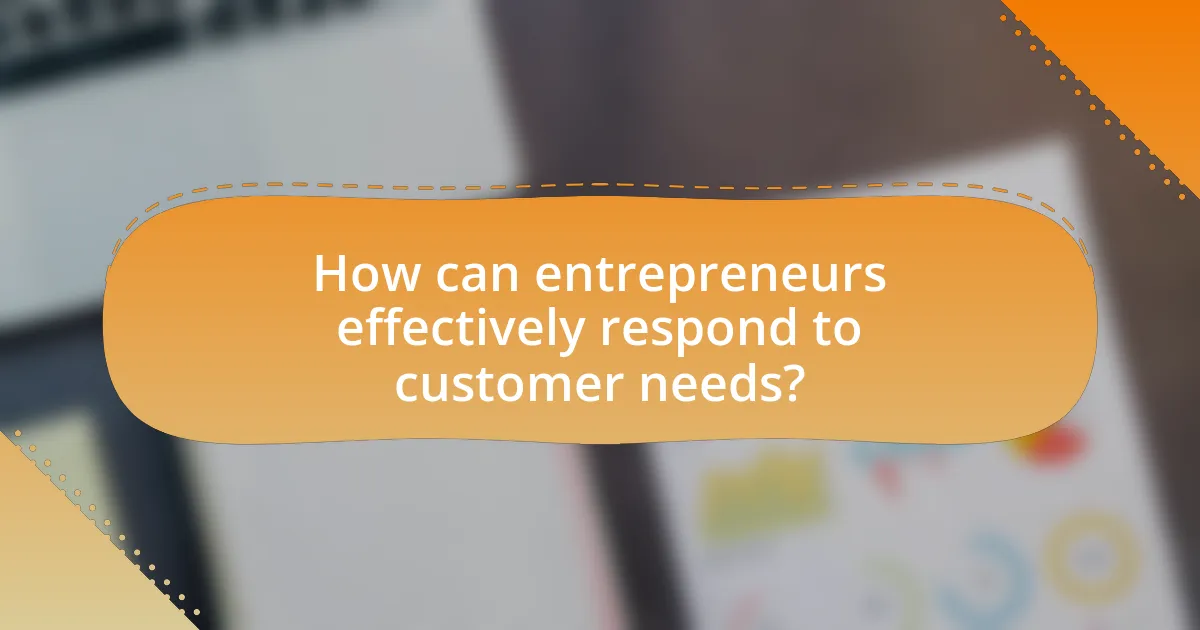Understanding customer needs is a critical process for entrepreneurs, involving the identification and analysis of customer preferences, expectations, and pain points to enhance product development and service delivery. This article outlines the importance of understanding customer needs, highlighting its impact on business strategy, customer satisfaction, and retention rates. Key elements of customer needs, including functional, emotional, social, and economic aspects, are discussed, along with methods for identifying these needs through market research and customer feedback. Additionally, the article addresses challenges entrepreneurs face in accurately interpreting customer feedback and the role of competition in shaping customer expectations. Strategies for effectively responding to customer needs and fostering a customer-centric culture within organizations are also explored, emphasizing the significance of continuous engagement and personalization in enhancing customer loyalty.

What is Understanding Customer Needs?
Understanding customer needs refers to the process of identifying and analyzing the preferences, expectations, and pain points of customers to enhance product development and service delivery. This understanding enables businesses to tailor their offerings to meet specific demands, thereby increasing customer satisfaction and loyalty. Research indicates that companies that effectively understand customer needs can achieve a 10-15% increase in customer retention rates, leading to higher profitability.
Why is understanding customer needs crucial for entrepreneurs?
Understanding customer needs is crucial for entrepreneurs because it directly influences product development, marketing strategies, and customer satisfaction. By accurately identifying and addressing these needs, entrepreneurs can create offerings that resonate with their target audience, leading to increased sales and brand loyalty. Research indicates that companies prioritizing customer insights are 60% more likely to achieve higher customer satisfaction scores, which correlates with improved business performance. Therefore, understanding customer needs not only shapes effective business strategies but also enhances competitive advantage in the marketplace.
What are the key elements of customer needs?
The key elements of customer needs include functional needs, emotional needs, and social needs. Functional needs refer to the practical requirements that customers seek to fulfill through a product or service, such as reliability and efficiency. Emotional needs encompass the feelings and psychological benefits that customers desire, such as comfort and satisfaction. Social needs involve the desire for connection and belonging, which can influence purchasing decisions. Understanding these elements is crucial for entrepreneurs, as research indicates that addressing both functional and emotional needs can lead to higher customer satisfaction and loyalty, ultimately driving business success.
How do customer needs influence business strategy?
Customer needs significantly influence business strategy by guiding product development, marketing approaches, and customer service initiatives. Businesses that prioritize understanding and addressing customer needs can create tailored offerings that enhance customer satisfaction and loyalty. For instance, a study by McKinsey & Company found that companies that effectively align their strategies with customer preferences achieve 10-15% higher customer satisfaction scores and increased revenue growth. This alignment allows businesses to adapt to market changes and consumer trends, ensuring they remain competitive and relevant in their industries.
How can entrepreneurs identify customer needs?
Entrepreneurs can identify customer needs through market research, customer feedback, and data analysis. Market research involves gathering information about target demographics, preferences, and behaviors, which can be achieved through surveys, focus groups, and interviews. Customer feedback, collected via reviews and direct communication, provides insights into satisfaction and areas for improvement. Data analysis, utilizing tools like Google Analytics, helps entrepreneurs understand purchasing patterns and trends. According to a study by the Harvard Business Review, companies that prioritize customer feedback are 60% more likely to retain customers, demonstrating the effectiveness of these methods in identifying customer needs.
What methods can be used to gather customer feedback?
Surveys, interviews, focus groups, and online reviews are effective methods to gather customer feedback. Surveys can be distributed via email or social media, allowing businesses to collect quantitative data on customer satisfaction and preferences. Interviews provide qualitative insights through direct conversations, enabling deeper understanding of customer experiences. Focus groups facilitate discussions among selected customers, revealing collective opinions and ideas. Online reviews on platforms like Google or Yelp offer spontaneous feedback, reflecting customer sentiments and areas for improvement. These methods collectively enhance a business’s ability to understand customer needs and adapt strategies accordingly.
How do market research and customer surveys contribute to understanding needs?
Market research and customer surveys are essential tools for identifying and understanding customer needs. They provide direct insights into consumer preferences, behaviors, and pain points, enabling businesses to tailor their products and services accordingly. For instance, a study by the American Marketing Association found that companies utilizing customer feedback through surveys saw a 10% increase in customer satisfaction and loyalty. This data-driven approach allows entrepreneurs to make informed decisions, prioritize features, and enhance customer experiences, ultimately leading to better market alignment and increased sales.
What challenges do entrepreneurs face in understanding customer needs?
Entrepreneurs face several challenges in understanding customer needs, primarily due to limited access to accurate data and evolving consumer preferences. The lack of reliable market research can lead to misinterpretations of what customers truly want, as many entrepreneurs rely on anecdotal evidence rather than comprehensive data analysis. Additionally, rapidly changing market trends and technological advancements can make it difficult for entrepreneurs to keep pace with shifting customer expectations. According to a study by the Harvard Business Review, 70% of startups fail because they misread customer needs, highlighting the critical importance of effective customer understanding.
How can biases affect the interpretation of customer feedback?
Biases can significantly distort the interpretation of customer feedback by leading to misjudgments about customer sentiments and needs. For instance, confirmation bias may cause entrepreneurs to focus on feedback that supports their existing beliefs while disregarding contradictory information, resulting in a skewed understanding of customer preferences. Research by the Harvard Business Review indicates that cognitive biases can lead to poor decision-making, as individuals often interpret data in a way that aligns with their preconceived notions. This misinterpretation can ultimately hinder the ability to accurately address customer concerns and improve products or services.
What role does competition play in shaping customer needs?
Competition plays a crucial role in shaping customer needs by driving innovation and influencing consumer expectations. When businesses compete, they strive to differentiate their offerings, which often leads to enhanced product features, improved quality, and better customer service. For instance, in the smartphone market, companies like Apple and Samsung continuously innovate to meet evolving consumer preferences, resulting in advanced functionalities that customers now expect as standard. This competitive pressure compels businesses to listen to customer feedback and adapt their products accordingly, ensuring that customer needs are not only met but anticipated.
How does understanding customer needs impact product development?
Understanding customer needs significantly impacts product development by ensuring that products are designed to meet actual market demands. When businesses accurately identify and analyze customer preferences, pain points, and behaviors, they can create solutions that resonate with their target audience. For instance, a study by the Harvard Business Review found that companies that prioritize customer insights in their product development process are 60% more likely to achieve higher customer satisfaction and loyalty. This alignment between product features and customer expectations leads to increased market success and reduced risk of product failure.
What strategies can entrepreneurs implement to better meet customer needs?
Entrepreneurs can implement strategies such as conducting regular customer feedback surveys, utilizing data analytics to understand purchasing behavior, and personalizing customer interactions to better meet customer needs. Regular feedback surveys allow entrepreneurs to gather direct insights from customers, which can inform product development and service improvements. Data analytics helps identify trends and preferences, enabling entrepreneurs to tailor offerings effectively. Personalization enhances customer experience by making interactions more relevant, which can lead to increased customer loyalty and satisfaction. According to a study by McKinsey, companies that excel in customer experience can achieve revenue growth of 5 to 10 percent above their market average.
How can personalization enhance customer satisfaction?
Personalization enhances customer satisfaction by tailoring experiences and offerings to individual preferences and behaviors. When businesses utilize data analytics to understand customer needs, they can provide relevant recommendations, targeted promotions, and customized communication. Research indicates that 80% of consumers are more likely to make a purchase when brands offer personalized experiences, demonstrating a direct correlation between personalization and increased customer satisfaction. This approach not only fosters loyalty but also improves overall engagement, as customers feel valued and understood.
What are the benefits of creating customer personas?
Creating customer personas enhances marketing effectiveness by providing a clear representation of target audiences. These personas allow businesses to tailor their messaging, product development, and customer service strategies to meet specific needs and preferences. Research indicates that companies using customer personas experience a 10% increase in conversion rates, as they can better align their offerings with customer expectations. Additionally, customer personas facilitate improved customer engagement by enabling personalized communication, which has been shown to increase customer loyalty and retention.

What are the different types of customer needs?
The different types of customer needs include functional needs, emotional needs, social needs, and economic needs. Functional needs refer to the practical requirements that customers have for a product or service, such as reliability and performance. Emotional needs involve the feelings and psychological aspects that customers seek to fulfill, such as status or belonging. Social needs pertain to the desire for connection and interaction with others, often influencing purchasing decisions based on peer approval. Economic needs focus on the financial aspects, including value for money and affordability. Understanding these categories helps businesses tailor their offerings to meet specific customer expectations effectively.
How do functional needs differ from emotional needs?
Functional needs refer to the practical requirements that customers seek to fulfill through a product or service, such as reliability, efficiency, and usability. In contrast, emotional needs encompass the psychological desires that drive customer behavior, including feelings of belonging, self-esteem, and personal satisfaction. For example, a customer may choose a smartphone not only for its technical specifications (functional need) but also for the status it conveys or the emotional connection it fosters with others (emotional need). Understanding this distinction is crucial for entrepreneurs, as addressing both types of needs can lead to more effective marketing strategies and enhanced customer loyalty.
What examples illustrate functional customer needs?
Functional customer needs are specific requirements that customers seek to fulfill through products or services. Examples include the need for reliable transportation, which is met by automobiles that provide safety and efficiency; the need for communication, fulfilled by smartphones that offer connectivity and functionality; and the need for convenience, addressed by online shopping platforms that allow easy access to products. These examples illustrate how businesses can effectively meet customer demands by focusing on the practical benefits their offerings provide.
How do emotional needs influence purchasing decisions?
Emotional needs significantly influence purchasing decisions by driving consumers to seek products that fulfill their desires for connection, security, and self-esteem. Research indicates that 70% of purchasing decisions are based on emotions rather than logic, highlighting the importance of emotional appeal in marketing strategies. For instance, brands that evoke feelings of nostalgia or happiness can create a stronger bond with consumers, leading to increased loyalty and repeat purchases. This emotional connection often outweighs rational considerations, as consumers prioritize how a product makes them feel over its functional attributes.
What role do latent needs play in customer satisfaction?
Latent needs significantly enhance customer satisfaction by addressing unexpressed desires that customers may not consciously recognize. When businesses identify and fulfill these latent needs, they create products or services that resonate more deeply with customers, leading to increased loyalty and positive experiences. Research indicates that companies that successfully tap into latent needs can achieve a competitive advantage, as they often exceed customer expectations and foster emotional connections. For instance, Apple’s innovation in user-friendly technology has consistently met latent needs for simplicity and aesthetic appeal, resulting in high customer satisfaction and brand loyalty.
How can entrepreneurs uncover latent needs?
Entrepreneurs can uncover latent needs by conducting in-depth customer research, including interviews, surveys, and observational studies. This approach allows them to gather insights into customer behaviors, preferences, and pain points that are not immediately expressed. For instance, a study by the Harvard Business Review found that companies that engage in qualitative research can identify unmet needs that lead to innovative product development. By analyzing customer feedback and market trends, entrepreneurs can identify gaps in the market and develop solutions that address these hidden demands.
What impact do unmet latent needs have on customer loyalty?
Unmet latent needs significantly diminish customer loyalty. When customers have needs that are not addressed, they may feel undervalued and dissatisfied, leading to a decrease in their emotional connection to the brand. Research indicates that 70% of customers are willing to switch brands if their needs are not met, highlighting the critical nature of addressing these latent needs. Furthermore, companies that successfully identify and fulfill latent needs can enhance customer satisfaction and retention, as evidenced by a study from Harvard Business Review, which found that businesses that prioritize understanding customer needs see a 10-15% increase in customer loyalty metrics.

How can entrepreneurs effectively respond to customer needs?
Entrepreneurs can effectively respond to customer needs by actively engaging in market research and utilizing customer feedback mechanisms. By conducting surveys, interviews, and analyzing customer behavior data, entrepreneurs can identify specific preferences and pain points. For instance, a study by the Harvard Business Review found that companies that prioritize customer feedback are 60% more likely to retain customers. This data underscores the importance of listening to customers and adapting products or services accordingly. Additionally, implementing agile methodologies allows entrepreneurs to quickly pivot based on customer insights, ensuring that their offerings remain relevant and valuable.
What are best practices for integrating customer feedback into business operations?
Best practices for integrating customer feedback into business operations include establishing a systematic process for collecting, analyzing, and acting on feedback. Companies should utilize multiple channels, such as surveys, social media, and direct communication, to gather diverse insights. Analyzing this feedback quantitatively and qualitatively allows businesses to identify trends and areas for improvement. Implementing changes based on customer input demonstrates responsiveness and fosters loyalty. Regularly reviewing feedback and measuring the impact of changes ensures continuous improvement. Research indicates that organizations that effectively integrate customer feedback can enhance customer satisfaction by up to 20%, leading to increased retention and revenue.
How can continuous improvement processes enhance customer satisfaction?
Continuous improvement processes enhance customer satisfaction by systematically identifying and addressing customer needs and preferences. These processes involve regularly evaluating and refining products, services, and customer interactions, which leads to higher quality offerings and better service experiences. For instance, companies that implement continuous improvement methodologies, such as Lean or Six Sigma, often report increased customer loyalty and retention rates. According to a study by the American Society for Quality, organizations that adopt continuous improvement practices can see customer satisfaction scores rise by up to 20%. This correlation demonstrates that ongoing enhancements not only meet but can exceed customer expectations, fostering a more positive relationship between the business and its clientele.
What tools can assist in tracking customer needs over time?
Customer relationship management (CRM) software, survey tools, and analytics platforms can assist in tracking customer needs over time. CRM systems like Salesforce and HubSpot enable businesses to collect and analyze customer interactions, preferences, and feedback, providing insights into evolving needs. Survey tools such as SurveyMonkey and Typeform allow for direct customer feedback collection, helping to identify changing expectations. Additionally, analytics platforms like Google Analytics and Mixpanel track user behavior and engagement, revealing trends that inform customer needs. These tools collectively provide a comprehensive approach to understanding and adapting to customer requirements over time.
What are the key takeaways for entrepreneurs in understanding customer needs?
Key takeaways for entrepreneurs in understanding customer needs include actively engaging with customers to gather feedback, utilizing data analytics to identify trends, and segmenting the market to tailor offerings. Engaging with customers through surveys and interviews provides direct insights into their preferences and pain points, which can inform product development. Data analytics, such as analyzing purchasing behavior, reveals patterns that help entrepreneurs anticipate customer demands. Market segmentation allows entrepreneurs to customize marketing strategies and product features for different customer groups, enhancing satisfaction and loyalty. These strategies are supported by research indicating that businesses prioritizing customer understanding achieve higher retention rates and revenue growth.
How can entrepreneurs create a customer-centric culture in their organizations?
Entrepreneurs can create a customer-centric culture in their organizations by prioritizing customer feedback and integrating it into decision-making processes. This involves actively soliciting input from customers through surveys, focus groups, and direct interactions, which helps to understand their needs and preferences. Research indicates that companies with strong customer-centric cultures, such as Amazon, achieve higher customer satisfaction and loyalty, leading to increased revenue. By fostering an environment where employees are encouraged to prioritize customer experiences and are trained to respond effectively to customer needs, entrepreneurs can ensure that their organizations remain aligned with customer expectations.
What practical steps can be taken to ensure ongoing engagement with customers?
To ensure ongoing engagement with customers, businesses should implement personalized communication strategies. Personalization increases customer satisfaction and loyalty; for instance, a study by Epsilon found that 80% of consumers are more likely to make a purchase when brands offer personalized experiences.
Additionally, businesses can utilize feedback loops by regularly soliciting customer opinions through surveys and reviews, which fosters a sense of involvement and shows customers that their input is valued. According to a report by Salesforce, 70% of customers say connected processes are very important to winning their business, highlighting the importance of integrating customer feedback into service improvements.
Moreover, maintaining an active presence on social media platforms allows businesses to interact with customers in real-time, addressing concerns and sharing relevant content. Research from Sprout Social indicates that 64% of consumers want brands to connect with them on social media, emphasizing the need for consistent engagement across these channels.
Lastly, offering loyalty programs can incentivize repeat purchases and enhance customer retention. According to a study by Bond Brand Loyalty, 79% of consumers say loyalty programs make them more likely to continue doing business with a brand. Implementing these strategies can significantly enhance customer engagement and foster long-term relationships.



